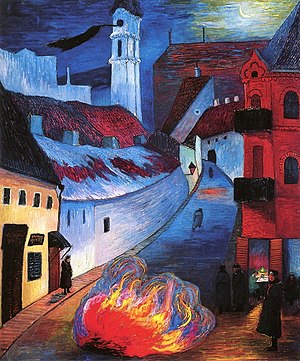Poste de police à Vilnius

|
| Poste de police à Vilnius |
|---|
| Marianne von Werefkin , 1914 |
| Tempera on cardboard |
| 98 × 82 cm |
| Fondazione Marianne Werefkin , Museo comunale d'arte, Ascona |
Poste de police à Wilna is the title of a painting that the Russian artist Marianne von Werefkin painted in 1914. The work belongs to the holdings of the Fondazione Marianne Werefkin (FMW) in Ascona . It has the inventory number FMW-0-0-33 there. There is an unspecified sketch for the painting in the “Sammlung J. u. M. Fontaine ”, which shows a large fire on a street where five people are warming themselves.
Technology and dimensions
The painting is a tempera painting on cardboard , 98 × 82 cm.
iconography
A fire blazes in an infernally aggressive manner in front of a police station in Vilnius . A lantern poorly illuminates the steep street. The sickle of the moon shines pale on the city. A black flag is blowing from the church tower. Four of the guards watch a colleague who is hurrying up the mountain and chasing a dark figure. As in several other pictures, Werefkin once again chose the colors red and blue as the basic tenor to stage a dramatic situation and supplemented this color combination with aggressive, flickering yellow. It is one of Werefkin's enigmatic images shortly before the First World War.
Dating
When the picture was taken in 1914, Vilnius was the "capital of the Russian governorate of the same name due to the influence of the Wileika in the Wilija , a junction of the St. Petersburg - Warsaw railways ". At that time, Werefkin's brother Peter had been "Governor General of Wilna, Grodno and Kovno " since 1912 , while at the same time he was in command of the Vilna Military District and the 3rd Army Corps. At the end of 1913, Werefkin's relationship with Jawlensky fell into a deep crisis again. Then she turned her back on Munich and went to see her brother Peter in Vilnius. She had made the decision not to return to Germany. Engaged in artistic missionary work, she appeared in 1914 in Vilnius with a public lecture. Jawlensky, Kandinsky and Schönberg played a leading role in it. At Nell Walden wrote to Berlin: "I have here in art school held a small presentation on the aims and purposes of art. People were beside themselves when I told them that the ability to create is much more than what has been created, that art lies more in what is not yet than in the treasures of museums. Here you want to paint like Raphael or like nature. ”The reactions of her audience were disappointing for her, the expressionist.
literature
- Clemens Weiler : Marianne von Werefkin. In exh. Cat .: Marianne Werefkin 1860-1938. Municipal Museum Wiesbaden 1958, cat.no.48, undated (p. 10)
- Bernd Fäthke: Marianne Werefkin. Munich 2001, p. 158, fig. 177, ISBN 3-7774-9040-7
- Brigitte Roßbeck: Marianne von Werefkin, The Russian from the circle of the Blue Rider. Munich 2010.
- Bernd Fäthke : Marianne Werefkin: Clemens Weiler's Legacy. In: Marianne Werefkin and the Women Artists in her Circle. (Tanja Malycheva and Isabel Wünsche eds.), Leiden / Boston 2016 (English), pp. 8–19, ISBN 978-9-0043-2897-6
Individual evidence
- ^ Jelena Hahl-Fontaine: New finds on the artist couple Jawlensky / Werefkin in Russian letters. In exh. Cat .: Lebensmenschen - Alexej von Jawlensky and Marianne von Werefkin. Städtische Galerie im Lenbachhaus and Kunstbau Munich, Munich 2019, p. 294, Fig. 2.
- ↑ Bernd Fäthke: Marianne Werefkin. Munich 2001, p. 159, fig .: 178, ISBN 3-7774-9040-7
- ^ Meyers: Large conversation lexicon. A reference book of general knowledge. Leipzig and Vienna 1909 vol. 20, p. 656
- ↑ Bernd Fäthke: Marianne Werefkin. Munich 2001, p. 13, ISBN 3-7774-9040-7
- ^ Meyers: Large conversation lexicon. A reference book of general knowledge. Leipzig and Vienna 1909 vol. 20, p. 656
- ↑ Brigitte Roßbeck: Marianne von Werefkin, The Russian woman from the circle of the Blue Rider. Munich 2010, p. 175 f.